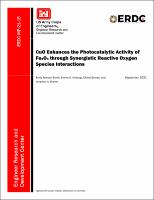Please use this identifier to cite or link to this item:
https://hdl.handle.net/11681/42131Full metadata record
| DC Field | Value | Language |
|---|---|---|
| dc.contributor.author | Asenath-Smith, Emily | - |
| dc.contributor.author | Ambrogi, Emma K. | - |
| dc.contributor.author | Barnes, Eftihia V. | - |
| dc.contributor.author | Brame, Jonathon A. | - |
| dc.date.accessioned | 2021-09-28T17:10:16Z | - |
| dc.date.available | 2021-09-28T17:10:16Z | - |
| dc.date.issued | 2021-09 | - |
| dc.identifier.govdoc | ERDC MP-21-15 | - |
| dc.identifier.uri | https://hdl.handle.net/11681/42131 | - |
| dc.identifier.uri | http://dx.doi.org/10.21079/11681/42131 | - |
| dc.description | Miscellaneous Paper | en_US |
| dc.description.abstract | Iron oxide (α-Fe₂O₃, hematite) colloids were synthesized under hydrothermal conditions and investigated as catalysts for the photodegradation of an organic dye under broad-spectrum illumination. To enhance photocatalytic performance, Fe₂O₃ was combined with other transition-metal oxide (TMO) colloids (e.g., CuO and ZnO), which are sensitive to different regions of the solar spectrum (far visible and ultraviolet, respectively), using a ternary blending approach for compositional mixtures. For a variety of ZnO/Fe₂O₃/CuO mole ratios, the pseudo-first-order rate constant for methyl orange degradation was at least double the sum of the individual Fe₂O₃ and CuO rate constants, indicating there is an underlying synergy governing the photocatalysis reaction with these combinations of TMOs. A full compositional study was carried out to map the interactions between the three TMOs. Additional experiments probed the identity and role of reactive oxygen species and elucidated the mechanism by which CuO enhanced Fe₂O₃ photodegradation while ZnO did not. The increased photocatalytic performance of Fe2O3 in the presence of CuO was associated with hydroxyl radical ROS, consistent with heterogeneous photo-Fenton mechanisms, which are not accessible by ZnO. These results imply that low-cost photocatalytic materials can be engineered for high performance under solar illumination by selective pairing of TMOs with compatible ROS. | en_US |
| dc.description.sponsorship | United States. Office of the Assistant Secretary of the Army for Acquisition, Logistics, and Technology. | en_US |
| dc.format.extent | 25 pages / 1.64 MB | - |
| dc.format.medium | PDF/A | - |
| dc.language.iso | en_US | en_US |
| dc.publisher | Cold Regions Research and Engineering Laboratory (U.S.) | en_US |
| dc.publisher | Geotechnical and Structures Laboratory (U.S.) | - |
| dc.publisher | Environmental Laboratory (U.S.) | - |
| dc.publisher | Engineer Research and Development Center (U.S.) | - |
| dc.relation.ispartofseries | Miscellaneous Paper (Engineer Research and Development Center (U.S.)) ; no. ERDC MP-21-15 | - |
| dc.relation.isversionof | Asenath-Smith, Emily, Emma K. Ambrogi, Eftihia Barnes, and Jonathon A. Brame. "CuO enhances the photocatalytic activity of Fe₂O₃ through synergistic reactive oxygen species interactions." Colloids and Surfaces A: Physicochemical and Engineering Aspects 603 (2020): 125179. https://doi.org/10.1016/j.colsurfa.2020.125179 | - |
| dc.rights | Approved for Public Release; Distribution is Unlimited | - |
| dc.source | This Digital Resource was created in Microsoft Word and Adobe Acrobat | - |
| dc.subject | Transition-metal oxide | en_US |
| dc.subject | Photocatalysis | en_US |
| dc.subject | Reactive oxygen species (ROS) | en_US |
| dc.subject | Advanced oxidation processes (AOP) | en_US |
| dc.subject | Colloidal | en_US |
| dc.subject | Heterogeneous photo Fenton | en_US |
| dc.title | CuO enhances the photocatalytic activity of Fe₂O₃ through synergistic reactive oxygen species interactions | en_US |
| dc.type | Report | en_US |
| Appears in Collections: | Miscellaneous Paper | |
Files in This Item:
| File | Description | Size | Format | |
|---|---|---|---|---|
| ERDC MP-21-15.pdf | 1.64 MB | Adobe PDF |  View/Open |